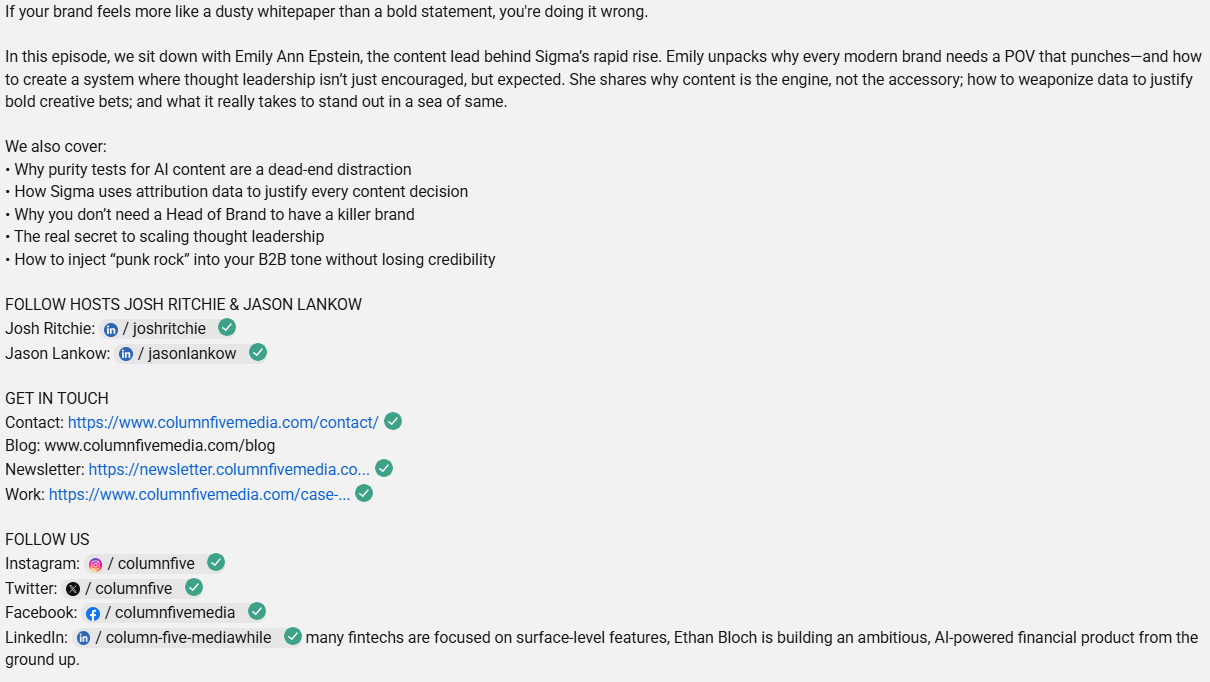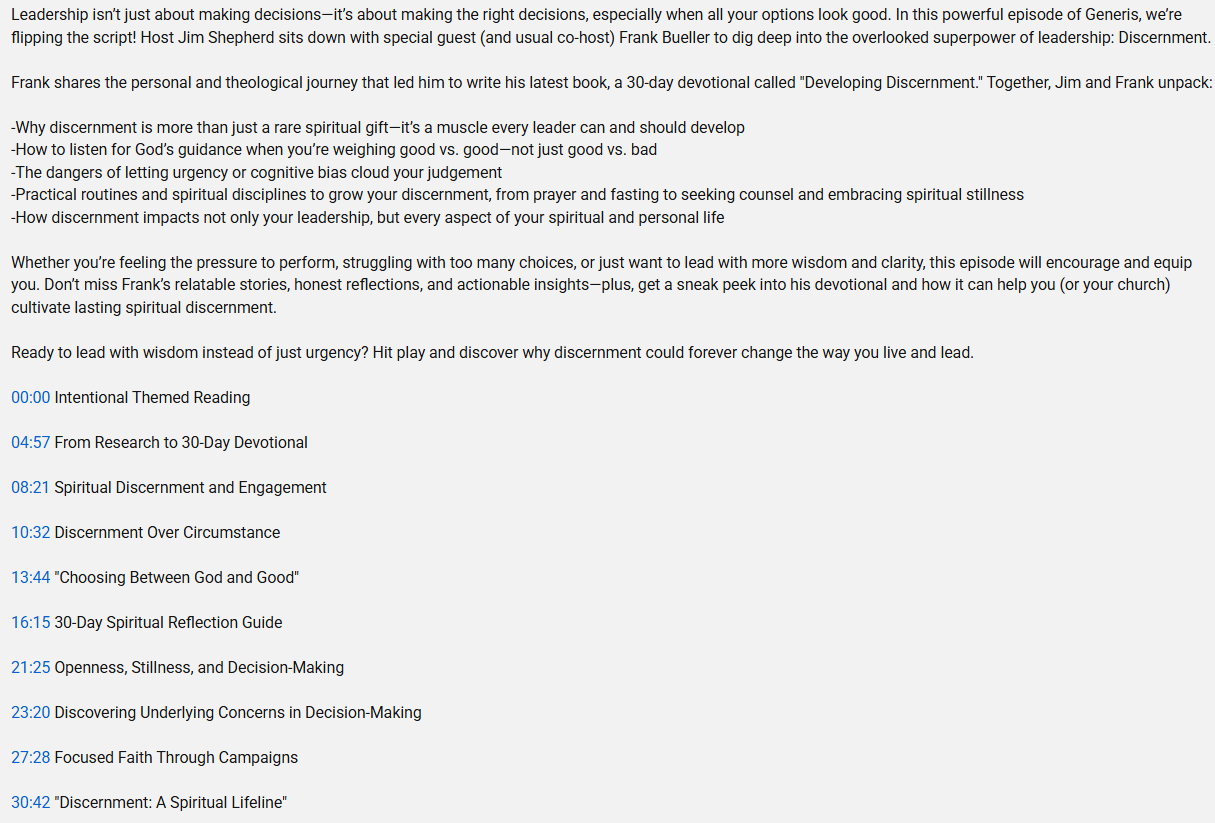Podcast Show Notes Template: How to Write Notes That Drive SEO, AI Discovery, and Conversions

Most podcast show notes are a total afterthought. There are a ton of shows out there that don’t provide them at all.
Those that do tend to slap them together minutes before publishing—just enough to make it live, but nowhere near enough to drive traffic, build trust, or support your content strategy.
That’s a massive missed opportunity.
Because done right, podcast show notes aren’t just a summary—they’re SEO fuel, AI discovery bait, and a bridge to conversions.
In this guide, we’ll break down exactly how to write podcast show notes that actually work in 2025. No fluff. Just the framework, tactics, and examples B2B marketers need to win.
What Are Podcast Show Notes?
Let’s start simple: Podcast show notes are the written content that accompanies a podcast episode (ya know, all the words that live in the ‘description’ most people never even read). They typically appear on podcast platforms (like Apple, Spotify, and Overcast), your website, and sometimes in your newsletter or social media posts.
Just because most people don’t take the time to scroll down and read your podcast show notes, doesn’t mean they aren’t valuable. This text plays a huge role in discoverability on all your podcast platforms, your website, and yep—Google.
You want new listeners? It’s time to take a look at your show notes.
Effective show notes include:
- A compelling, SEO-friendly episode title
- A short summary or hook
- Key takeaways in bullet form
- Host and guest info and relevant links
- CTAs for subscribing or learning more
- (Optional) Timestamps for key moments
Want to take it a step further? Include a full-blown blog post or website article. But we break that down here.
At Sweet Fish, we see show notes as a strategic tool, not just a summary. They play a huge role in your show’s discoverability—on Google, in AI tools like ChatGPT and Perplexity, and even within podcast apps themselves.
Why B2B Podcasts Need Better Show Notes in 2025
If you're producing a B2B podcast to fuel thought leadership or demand gen, your show notes aren’t optional, unless you want to sacrifice discoverability.
Here's why:
1. They Supercharge SEO
Google can’t index audio (at least not yet), but it can index your show notes. That means every well-written episode summary is another chance to rank for high-intent keywords, show up in featured snippets, and generate long-tail traffic.
2. They Surface in AI Tools (GEO Optimization)
AI tools like ChatGPT, Claude, and Perplexity are increasingly serving as “zero-click” search engines. When someone asks, “What should I include in podcast show notes?”—well-structured content with clear headers, bullet points, and direct answers is more likely to get pulled.
This is why clear headers, bullet-pointed content, and clear topic overviews (formulated based on search intent) are pretty important.
3. They Drive Listener Conversions
Not everyone hits play right away. Show notes act as your pre-sale pitch. When they’re done right, they turn skimmers into subscribers and listeners into leads.
By making sure you’re including main topics in your show notes, listeners know they’ll find the answer or topic they’re looking for and are much more likely to commit 20-45 minutes to listening to the full episode… which works full circle, right? More play time to build that audience relationship and keep them coming back for more.
The Sweet Fish Podcast Show Notes Template (2025 Edition)
Ready to write notes that rank, resonate, and convert? Here’s our go-to template—refined from hundreds of B2B podcast episodes and optimized for both humans and search engines.
P.s. We’ve produced 400+ B2B podcasts, we’ve learned a thing or two.
1. SEO-Optimized Episode Title
This isn’t just the episode name—it’s your blog title, your page’s H1, and your social post headline. Make it strong.
We can edit and tweak depending on where your episode is going live… but we need to make sure that title is catchy, evokes emotion, and makes someone want to listen. Just remember—no clickbait. Deliver on your title promise.
Bad:
Episode 48: Interview with Jane Smith
Better:
How Jane Smith Scaled B2B Revenue by $10M Using Customer Advisory Boards
Let’s look at another one…
Bad:
Conversation on The Risk of AI in Software Development Today
Better:
Will AI Replace Developers This Year?
Maybe one more?
Bad: Common Inclusivity Gaps in Event Planning
Better: The Inclusivity Gaps Every Planner Overlooks
Use keywords and results-oriented language. Aim for 60–70 characters max. And really lean into search intent and evoking emotion. Create a title designed for your audience, what they care about, and what they would actually click on.
One-Line Hook or Bold Promise
Give readers a reason to keep scrolling—or start listening. This is the text that will show up on podcast platforms right before that little See More… button. It’s important because this hook is something people will see, whether or not they read your entire show notes section.
Your hook should work well with your Tite… add intrigue, hint towards answers, or lead further down the rabbit trial you started with those first few characters.
Examples:
- “We unpack how to turn customer interviews into marketing gold.”
- “Your vendor list can make or break your success as a corporate event planner.”
- “Why so many companies default to hiring massive consulting firms like IBM, Accenture, or Deloitte—only to be underwhelmed by the results.”
- “If your job feels like a never-ending list of tasks with unclear goals and shifting expectations, you're not alone.”
- “Security is essential… but compliance is the key that unlocks budget, board buy-in, and influence.”
This also helps with meta descriptions and previews on AI results pages.
3. Summary Paragraph (2–3 Sentences)
Set the scene with a quick, clear overview. What’s in the episode, and why does it matter to your ICP?
Examples:
1. In this episode of B2B Growth, we chat with Jane Smith, VP of Marketing at RevRocket, about how she used customer advisory boards to shape product messaging, drive retention, and generate $10M in new ARR. You’ll learn how to structure your own board—and what not to do.
2. In this episode, we’re breaking down how top planners build, refine, and protect their vendor lists. You’ll learn how to identify the best vendors, the red flags that should take someone off your list immediately, and the strategies to ensure you always have the right team for every event.
3. We'll break down the real risks and rewards of going with the “safe” choice in software development, and how entrenched procurement processes can stifle innovation and make it tough for nimble, specialized consultancies to get a foot in the door.
4. In this first episode of All the Hats, Ómar Thor Ómarsson and Alicja Lei talk about what it’s really like to be a marketer on a small team. They swap stories from their own careers, react to a viral Reddit post about unrealistic workloads, and make the case for why saying no is sometimes the smartest move you can make. It’s part vent session, part strategy chat, and a reminder that doing everything isn’t the same as doing the right things.
5. In this episode, Aftab and Scott break down how savvy CISOs are turning compliance from a burden into a budget multiplier.
4. Key Takeaways (Bulleted List)
This is your skimmable value. Helps with user experience and gives AI tools a tidy list to extract.
- How customer interviews inform product positioning
- Why most advisory boards fail (and how to fix that)
- A playbook for launching one in 30 days
- Real examples from Jane’s playbook
5. Host & Guest Info + Links
Have a guest-based show? Make sure you share who they are and where they can be found. LinkedIn links, email address, social handles, or website—ask your guest which they prefer.
No guest, no problem. Include your host and brand’s information. If your audience wants more (or wants to connect), minimize the work they have to do to find you. Keep it in the show notes!
6. Links + CTAs
Point to your lead magnets, service pages, or next step. Always, always be webbing your content so your biggest fans (and champions) have something else to move on to if they’re in the mood for more you.
Example:
- Download our free resource
- Learn more about [topic you have more material on]
- Subscribe on Apple, Spotify, or YouTube
- Listen to our last episode on [topic]
7. (Optional, but valuable) Timestamps
Especially useful for long episodes or technical content.
Example:
00:00 - Intro
03:45 - The Origin of RevRocket’s Advisory Board
09:20 - Key Pitfalls to Avoid
15:55 - Launch Plan for New Boards
27:00 - Final Advice for B2B Marketers
Timestamps also help with AI parsing and featured snippet inclusion.
Podcast Show Notes: Before & After
Let’s take a real-world example and show how small tweaks can make a huge difference.
BEFORE (Boring & Ineffective)
Episode 23: A Chat with Mike about SaaS
In this episode, we talk to Mike about marketing and stuff.
AFTER (Optimized & Valuable)
Title: How Mike Brown Used Community to Reduce SaaS Churn by 40%
Hook: Discover the retention tactics that helped Mike save $1.2M in ARR.
Summary: Mike Brown, Head of Growth at ChurnZero, explains how community-led marketing reduced churn and boosted customer lifetime value.
Takeaways:
- How to build a SaaS community from scratch
- Key engagement tactics
- Results from 6 months of testing
CTA: Download the B2B Podcast Retention Playbook
Podcast Show Notes Examples — The Winning Few


Best Practices for Podcast Show Notes in 2025
Whether you DIY or use AI to draft, keep these tips in mind:
- Write for skimmers. Use headers, bullets, and short paragraphs.
- Lead with value. Hook the reader before asking them to listen.
- Use your keywords—but don’t stuff. Focus on clarity.
- Don’t bury your CTA. Mention it early and clearly.
- Leverage AI tools smartly. Use AI for structure or first drafts, but always humanize your tone and CTA.
- Cross-link internally. Point to related blog posts, episodes, and resources to boost SEO.
Want Help Turning Episodes Into Discoverability Fuel?
At Sweet Fish, we don’t just publish podcasts—we turn them into content engines.
If you want to make your podcast drive actual pipeline—not just downloads—we’ll help you create notes, blogs, audiograms, and more. Let’s talk strategy.